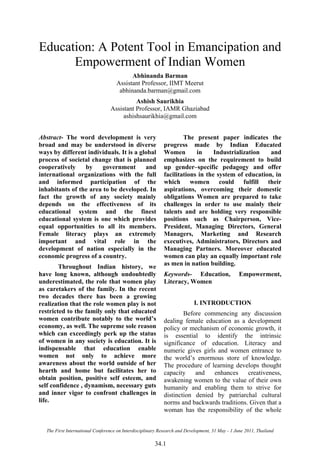This document discusses the importance of education in empowering Indian women. It argues that education enables women to gain awareness, self-confidence, and skills to confront challenges in life. Educated women can contribute significantly to the economy and act as agents of social and economic development. The document presents statistics showing that female literacy rates and work participation rates have increased in India in recent decades, though gaps between rural/urban and male/female rates still exist. It also discusses government initiatives to promote women's education and empowerment through programs like Mahila Samakhya. Overall, the document emphasizes that education is a powerful tool for emancipating and empowering Indian women.







![Abhinanda Barman and Ashish Saurikhia
urbanization, spasmodic mobility and social
legislation. In sum, where humanism fails,
economics makes a strong case for educating
women. The contribution of an educated
woman stretches far beyond bolstering her
own capabilities and improving her own life
and hence of her offspring. This, in turn, will
raise productivity, realign social priorities
and go a long way to bringing societies out
of poverty.
REFERENCES
Books
[1] Anil Bhuimali (2004): “Education, Employment
and Empowering Women”, Serials Publications,
New Delhi.
[2] Arun C.Mehta (2006): “Elementary Education in
India”, National Institute of Educational
Planning and Administration, New Delhi.
[3] Ghose Malini (2002): “Literacy, Power and
Feminism”, Economic and PoliticalWeekly, Vol
37, No.17, April 27, P.1615-1620
[4] Parikh J, and Garg, Pulin k, “Indian Women an
Inner Dialogue” Sage Publications, New Delhi
1989
[5] Calmen, L. 1992. Toward Empowerment: Women
and Movement Politics in India. Boulder:
Westview Press
Journals and Papers
[6] Economic Survey 2007-08, Government of India.
[7] Government of India – Selected Educational
Statistics, Ministry of Human Resource
Development, Govt. of India, (Various Years).
[8] Government of India (2001) – Census of India
2001 General Population Tables, Office of the
Registrar General, Min. of Home Affairs, Govt.
of India.
[9] Government of India: Census of India 1991,
Government of India New Delhi 1993.
[10]Hossain Naomi, Naila Kabeer (2004):
“Achieving Universal Primary Education and
Eliminating Gender Disparity”, Economic and
Political Weekly, September 4, P.4093-4099.
[11]Mukherjee, Dipa (2007) “Women’s Education in
India: Trends, Interlinkages and Policy Issues”,
MPRA Paper No.4871.
[12]Parikh Kirit.S and Chirajib Gupta (2001): “How
Effective Is Female Literacy In Reducing
Fertility?”, Economic and Political Weekly, Vol
36, No.35, September 1, P.3391-3398.
[13]03-06, Indian Institute of Management,
Ahmedabad, March 2004
[14]Parikh, Indira J, “Women Managers in
Transition”, From Homes to Corporate Offices’
The Indian Journal of Social Work, Bombay
1994
[15]Parikh Indira and Engineer, Mahruk , “Women in
Management – A movement from fiftees to next
millennium”,
[16]Working Paper No. 99-12-00, Indian Institute of
Management, Ahmedabad, December 1999
[17]Girls’ And Women’s Education,Policies and
Implementation MechanismsSynthesis of Five
Case Studies: India, Indonesia,Laos, Nepal,
Thailand, BY Linda Pennells, Planning and
Sector Analysis Unit UWwl Unesco Principal
Regional Office, For Asia and The Pacific,
Bangkok, 1998
[18]IIM, Ahmedabad, WP No. 2005-08-07; A
reflection of the Indian Women in the
Entrepreneurial World.
Footnotes:
1
Research Centre for Educational Innovation and
Development (CERID) /National Non-Formal
Education Council (1997) Impact Study of Adult
Education in Nepal, Kathmandu.
2
National Sample Survey - Fiftieth Round,
Government of India 1993/94, table 19.
3
The 1966 Education Commission report notes a
significant number of administrators, opinion leaders
and commentators argued that provision of a second-
best alternative in the form of non-formal education
was morally indefensible.
4
Examples include Mahila Shikshan Vihar and Mahila
Shikshan Kendra
Special Issue of the International Journal of the Computer, the Internet and Management, Vol. 19 No. SP1, June, 2011
34.8](https://image.slidesharecdn.com/023407eabhinandabarman8-140724135114-phpapp02/85/02-34-07_e_abhinanda-barman_-8-8-320.jpg)